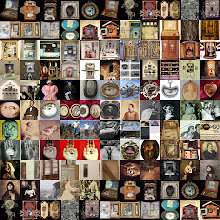





Today I went to the Tate with a group of fellow MA students and professor Paul Coldwell. I had chosen two artists to view, Arnulf Rainer and Anish Kapoor. I have had an interest in Rainer from his huge canvases of dripping paint, gestures and hand prints. He is associated to art informel (Hans Hartung, Rothko, Motherwell, Newman) and Viennese Actionism (Gunter Brus, Hermann Nitschz). His work often destroys form, through covering, repainting, crossing and masking. His approach to printmaking in Five Reds explores the process of scratching the plate in drypoint, this with the use of red, inevitably brings me to identify the act as a violent agression towards the passive surface, which repeatedly wounds to bring to the surface the red bright blood. The shades of red go from bright oxygenated blood from the inside of live organs and arteries to dark carmine of blood from shedding veins.





Kapoor's series Blackness from her Womb, on the otherhand represents the uterus as 'injury, darkness and foreboding but also aligns it with the landscape and evoke(s) it as a refuge.' (tate website). Four phrases follow the title in the print portfolio: Crows are calling/Blackness from her womb/Valley of Red/Wounded walls of tranquility.
The womb is the wound and foreboder, bringing the news of death and bloodspilling (menstruation and symbolic death of the child). The womb as a black void is alluded by his use of the deep etching black, which he mixes with one single colour for each print (with chine colle). This negative engulfing space is also present in his sculpture, the 'void as fear towards loss of self, consumed by the object, or in the non-object, in the body, in the cave, in the womb', a notion of the sublime.
Both artists allude to landscape, Rainer in his titles-'Red Fields', 'Violet Furrows'-and Kapoor in his opening words-'valley of red'- and visually. This emphasises for me the identification of the female as nature, specially in Kapoor, and of the plate as 'materia prima' (raw material, natural resource) and passive receiver.
If we think of the term matrix, used in printmaking to refer to the plate, we can see how the female, nature and passive become one. According to Victoria Sau, the identification of woman with nature is due to the 'kidnapping of the Mother' by the Father, which takes over creation and death and reduces her to mother, the physical phenomenons of pregnancy and labour, stripped from higher cultural value. In this view, the plate in Rainer is as the passive feminized body which receives creation from the artist, and in Kapoor she is a threatening landscape of death and rebirth.



